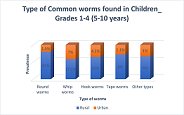
Imagine your favorite outdoor spot. Now picture it being invaded by these sneaky little worms. That’s the stark reality for farmers and ranchers who find their animals affected by wolf worms. These parasites can wreak havoc, leading to health problems for affected animals and economic distress for their owners. Just like a pesky remote that won’t sync—no matter how many times you reset it—wolf worms can be incredibly frustrating to deal with. Here’s what you need to know about their infestation rates in rural areas and why it matters.
What Are Wolf Worms?
Wolf worms, or *Cuterebra*, are the larval form of a type of fly. They typically target animals like rabbits, squirrels, and even domestic pets. You might be wondering, “How do these worms even get into their host?” Well, the adult fly lays eggs near burrows or nests. When the host comes into contact with the eggs, the larvae attach themselves and start their life cycle inside. It’s a bit like an unwelcome houseguest that just won’t leave.
This parasitic relationship can lead to a range of problems for the host. For instance, the larvae can cause infections, leading to symptoms like swelling and pain. If left untreated, it can even be life-threatening. The presence of wolf worms in rural areas often raises concerns about animal health, making it crucial for pet owners and farmers to stay informed.
Infestation Rates in Rural Areas
Infestation rates of wolf worms can vary widely depending on the region and environmental conditions. In the rural United States, these rates can be surprisingly high, particularly during warmer months. As temperatures rise, the lifecycle of the fly accelerates, leading to more opportunities for infestations. Think of it like a light switch being flipped on; once the right conditions are met, things can get out of hand quickly.
Farmers and ranchers often report increased sightings during late spring and summer. This is when the adult flies are most active, searching for hosts to lay their eggs on. In some cases, one infested animal can lead to an uptick in cases within the local area. It’s a bit like how one bad remote can cause confusion across multiple devices—one wolf worm can create a chain reaction.
Signs of Wolf Worm Infestation
Recognizing the signs of a wolf worm infestation is critical for any animal owner. So, what should you be on the lookout for? Here are some common indicators:
- Swelling or lumps: You might notice abnormal swelling on your pet’s body, particularly near the head, neck, or back.
- Discomfort: If your pet is acting unusually sensitive or showing signs of pain, it might be due to a worm infestation.
- Behavior changes: Animals might become withdrawn or refuse to eat if they’re feeling unwell.
If you spot any of these signs, it’s essential to consult a veterinarian as soon as possible. Early intervention can help prevent further complications, much like catching a problem with a remote before it affects the whole home theater setup.
How to Manage and Prevent Infestations
Managing wolf worm infestations requires a proactive approach. Here are a few tips to keep your animals safe:
- Regular check-ups: Make sure to schedule regular veterinary visits, especially during peak seasons.
- Keep living areas clean: Reducing clutter around animal living spaces can help prevent flies from laying eggs.
- Monitor wildlife: Be aware of wildlife in your area, as they can carry wolf worms and potentially transmit them to pets.
If you suspect an infestation, it’s crucial to act quickly. Your vet can provide the necessary treatment, often involving the removal of the larvae and any medications to treat infections. Think of it like troubleshooting a faulty remote; the faster you identify the issue, the quicker you can regain control.
Economic Impact of Wolf Worm Infestation
The economic repercussions of wolf worm infestations can be significant, especially in rural areas. Farmers may face losses due to decreased productivity in livestock, medical costs for treatments, and even potential loss of animals. Just like how a malfunctioning remote can disrupt your favorite movie night, an infestation can throw a wrench in the daily workings of a farm or ranch.
The costs don’t end with treatment. If animals are unable to perform at their best, farmers may see lowered milk production or weight gain in livestock, directly impacting their income. Understanding and managing these infestations is vital for the sustainability of rural agricultural practices.
Local Variation and Trends
Infestation rates can vary widely based on geographical locations. In some rural areas, local climate conditions encourage higher rates of infestation. For instance, regions with longer warm seasons may see more wolf worms compared to colder climates. You might note that certain areas have more frequent reports, and this could be tied to both environmental factors and local wildlife populations.
Farmers in these regions often form communities and share strategies for managing wolf worm issues. This collaboration resembles a support group for troubleshooting remote issues—everyone helps each other out through shared experiences and solutions.
Wolf worm infestations in rural areas are a real concern for livestock owners and pet parents alike. Understanding these pests, recognizing the signs of infestation, and taking preventive measures can be key to protecting both animal health and economic interests. By staying informed and working closely with local veterinarians, people in rural communities can minimize the impact of these unwelcome guests.
As you sip your coffee and think about your own favorite outdoor spaces, consider the animals that inhabit them. Just like you wouldn’t want a pesky remote ruining your movie night, keeping wolf worms at bay ensures a safer, healthier environment for beloved pets and livestock. It’s all about taking proactive steps and staying aware.
